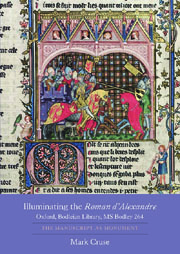 Illuminating the 'Roman d'Alexandre': Oxford, Bodleian Library, MS Bodley 264
Illuminating the 'Roman d'Alexandre': Oxford, Bodleian Library, MS Bodley 264 Book contents
- Frontmatter
- Contents
- List of Illustrations
- Acknowledgements
- Abbreviations
- Introduction
- 1 A Monument to Cortoisie
- 2 Urban Conquest and Spectacle
- 3 “Apraigne d'Alixandre”: Illuminating Exemplarity in Bodley 264
- 4 Alexander, Crusade, and the East in Bodley 264
- 5 The Production, Patronage, and Later Reception of Bodley 264
- Conclusion: Alexander in the Late Middle Ages
- Afterword: Mirror In Pixels
- Bibliography
- Index
- Already Published
2 - Urban Conquest and Spectacle
Published online by Cambridge University Press: 05 February 2013
- Frontmatter
- Contents
- List of Illustrations
- Acknowledgements
- Abbreviations
- Introduction
- 1 A Monument to Cortoisie
- 2 Urban Conquest and Spectacle
- 3 “Apraigne d'Alixandre”: Illuminating Exemplarity in Bodley 264
- 4 Alexander, Crusade, and the East in Bodley 264
- 5 The Production, Patronage, and Later Reception of Bodley 264
- Conclusion: Alexander in the Late Middle Ages
- Afterword: Mirror In Pixels
- Bibliography
- Index
- Already Published
Summary
As the previous chapter demonstrates, a principal function of Bodley 264 was to vivify the imagined connection between ancient and medieval cortoisie. Yet Bodley 264 is exceptional not only as a courtly object, but as the manifestation of a remarkable moment in the history of European urbanization. Produced in Tournai, Bodley 264 belongs to the extraordinary profusion of urban cultural expression in northern France and the Low Countries (le Nord, ‘the North’) during the late Middle Ages. As has long been noted, le Nord was among the first regions in Europe to become urbanized, to have powerful urban patriciates and civic associations largely independent of feudal lords, and to have an economy focused on urban production and consumption. This economic and political power was accompanied by a social dynamism that is often understood as the motor for profound shifts in the history of visual art, theater, devotion, literature, and manuscript production. It is therefore necessary to consider Bodley 264's relationship not only to the courtly society for which it was produced, but to the urban society to which its conceptualizer, artists, and scribes belonged.
There was in fact no clear distinction between courtly and urban societies in the North in the fourteenth century, but rather a deep interpenetration on the social, political, economic, and cultural levels. The rulers of the various principalities in northern France and the Low Countries remained itinerant for much of the fourteenth century, with residences in various cities and towns.
- Type
- Chapter
- Information
- Illuminating the 'Roman d'Alexandre': Oxford, Bodleian Library, MS Bodley 264The Manuscript as Monument, pp. 61 - 102Publisher: Boydell & BrewerPrint publication year: 2011
